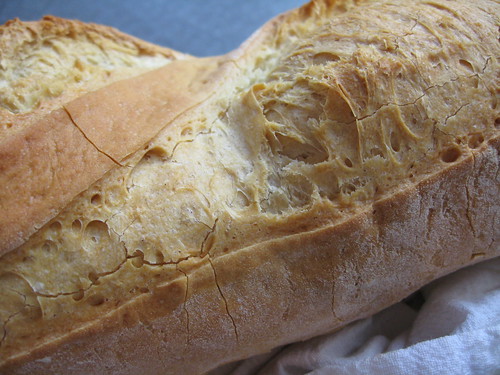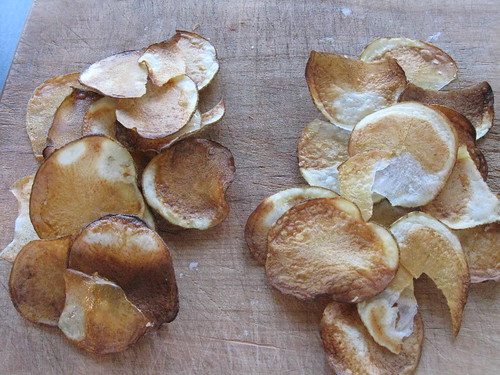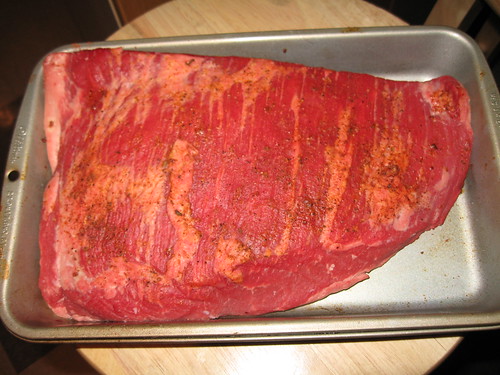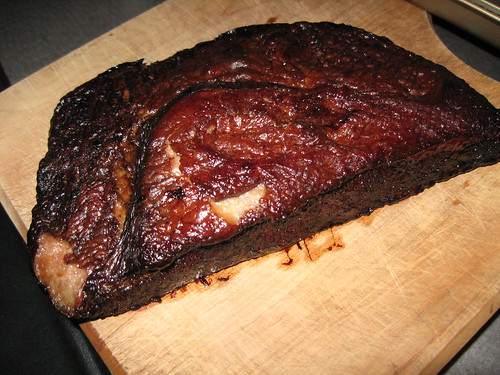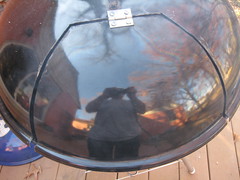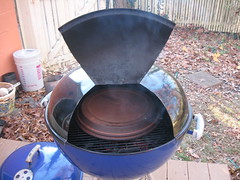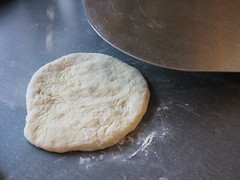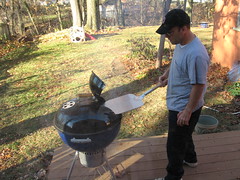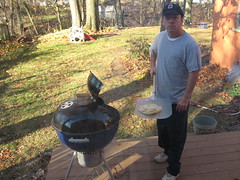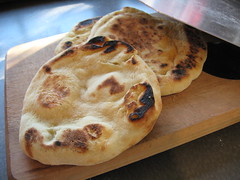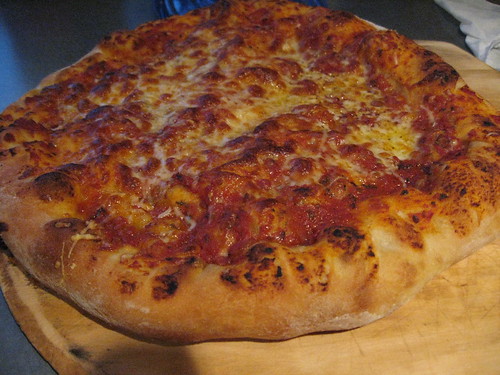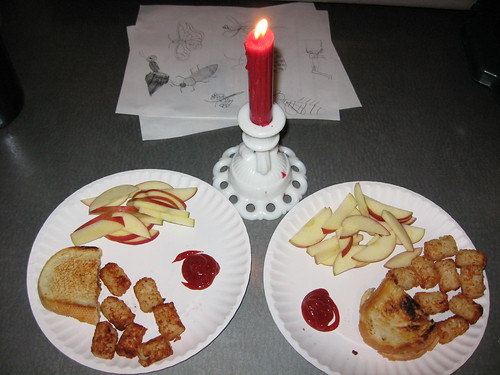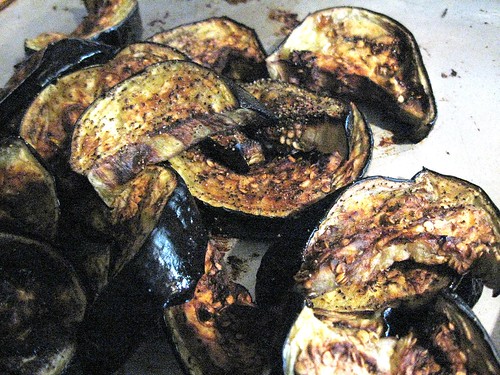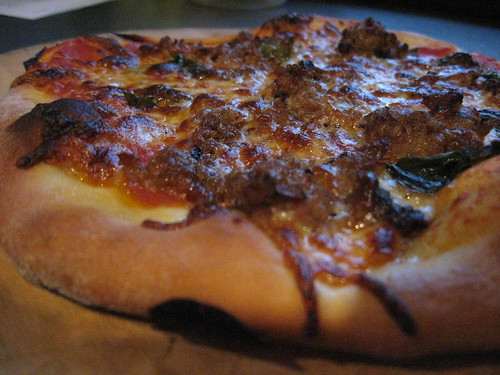In which I embarrass my wife.
1.11.2009
Baguette Prep Video, Part 2 of 3, Loaf Formation
In which I embarrass my wife.
12.29.2008
Potato Chips
Years ago, I deep fried some mandoline-sliced sweet potato slices. They were absolutely perfect, but deep-fried. Today, I took the mighty russet and sliced it on a mandoline slicer. The slices were soaked in water for about 10 minutes, removed from the slurry of water and extracted starch and left to air dry (about 15 minutes). They were placed on an oiled, black cookie sheet (in a single layer), dabbed with a tad of soy oil using a paint brush (I would've used a spray can of veg oil, but had none) AND baked at 425°F (convection) for about 10 minutes. Voilà.
Why the two piles? Stay tuned ...
12.26.2008
Final steps in baguette prep
Third in a series, but I need to film the first two. If that makes sense. Hope you enjoy this while waiting for the beginning pieces.
12.25.2008
Winter brisket
I've only tackled brisket once before. It was ok, but I gave it too much of a rub; a piece like this, doesn't need it. I did a combo cooking method that worked swimingly. A week ago or so it was really windy and about 18°F. Good day for barbecue I thought. I fired up my trusty Weber at about 5:30 am and tossed on the meat, fat side up of course, and let it smoke for about 5 hours using Kingsford embedded with hickory. Temp in the dome, about 275°F. A little erratic with the blustery wind but not bad.
Suddenly, family matters dictated we needed to dash. I pulled the meat off since I didn't know how long we'd be away. I placed it in a small pan (and kept the smoky drippings for later!) and placed it in a 200°F oven (a la Wolfert's Slow Mediterranean Kitchen) and let it go for about an additional 6 hours. See the after pic.
I wrapped the brisket in foil for and parked it in the fridge. Warmed gently a couple days later immediately reminded us of the wonderful 'q aroma, it was served with baked sweet potatoes. If I were on death row, this might be the final meal I request. I no longer fear the bbq challenge of brisket. Not a very expensive cut, BIG crowd pleaser, not too fatty by the time it's finished. Be brave, bbq a brisket.
12.15.2008
My aromatic tasty nuts
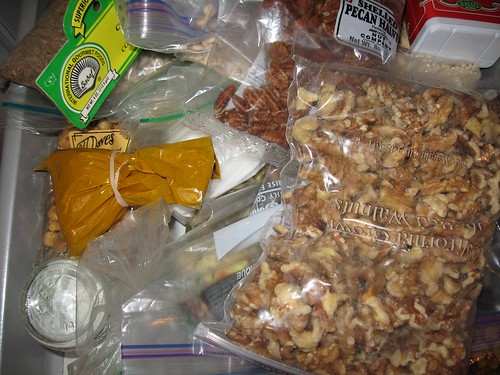
Saturday morning breakfasts are pedestrian in our home. Not quite gruel ... or ... yeah, it is gruel. We often have mixtures of grains (oats, old-fashioned or steel cut, rye or wheat berries, quinoa, what germ, flaxseed, etc.) mixed with 2 volumes of water and simmered until tender. This concoction's beauty is realized when we add the toppings. A drizzle of cool whole milk and a sprinkle of brown sugar are mandatory.
We also top the porridge with walnuts or pecans, lightly toasted in cast iron just prior to topping. The secret to our special nuts is the way we store them. We have a spice overflow drawer. Here we store all the spices for a nice garam masala, coconut, cardomom, cinnamon, paprika, and other savories that don't fit in the spice shelf. Over time, these nuts inherit a special curry flavor that is subtle but special. The specific flavors could never be duplicated - which is good. It evolves over time and surprises us each breakfast.
12.10.2008
Roasted Cauliflower, Israeli couscous, pine nuts and raisins
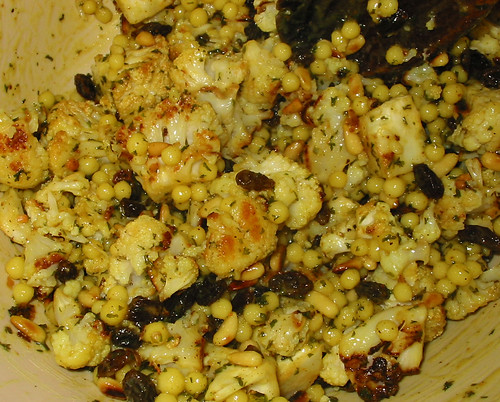 It's the holidays and I thought I'd repost one of my favs since:
It's the holidays and I thought I'd repost one of my favs since:
a. no one reads my archives and
b. I got some free loot!
It's the frigging holidays and time for those excruciating office parties. Occasionally these require one to bring a dish. The depicted dish is perfect. It can be prepared the night before, tastes best at room temperature and it's healthy.
Also, I got a few freebies from OH Nuts!, a nut company in New York. A whole pound of pine nuts from them is about $12. The big difference with these vs. what I usually get (lately, from Mediterranean Market, when we can afford them) is they're really crisp out of the bag. I toast them for this dish, but they're really tasty toasted or not. Frankie now gets them in her lunch!
Thanks OH Nuts!, we're enjoying them! This dish is nice for them too.
Original Post
The wife pointed out this recipe for roasted cauliflower with Israeli couscous, pine nuts and raisins. It's seasoned with salt, pepper, turmeric and the giant couscous is briefly sauteed in olive oil and then cooked in chicken stock. I think it's a new "desperation dinner" for us. The longest step is roasting the cauliflower which takes about 20 minutes at 425F. The recipe also called for fresh parsley or cilantro; all I had to use was dried parsley. I'll fix that next time. Trust me, it's better than it looks. Recipe reprinted in case the link goes dead:
1 small cauliflowerClick the photo for a larger view.
4 cloves garlic, crushed
3 Tbs olive oil
1 onion, peeled and chopped
1 tsp turmeric
1 1/2 cups giant couscous (also called Israeli couscous) or fregola
2 1/2 cups chicken stock
sea salt and freshly ground black pepper
1/2 cup toasted pine nuts
1/4 cup currants
1/2 cup chopped fresh coriander or parsley
1. Preheat oven to 170C. Cut cauliflower into small even-sized florets and place in an oven pan. Combine the crushed garlic with 2 tablespoons olive oil, pour garlic oil over the cauliflower and toss well to coat. Roast for 30 minutes or until the florets turn golden brown, stirring occasionally to allow for even cooking. Remove to cool.
2. At the same time, heat a saucepan, add 1 tablespoon olive oil and the onion and cook over a moderate heat for 5-10 minutes until softened but not coloured. Stir in the turmeric and giant couscous and cook for 1 minute, stirring continually.
3. Add stock and bring to the boil, then turn down the heat and simmer for 8-10 minutes, stirring regularly until the grains are tender to the bite and all the liquid has been absorbed. Season with salt and pepper to taste.
4. Stir through the roast cauliflower, pine nuts, currants and coriander or parsley and serve.
Update
I prepared this with the other half of the cauliflower several days later. The only change I did was cook the giant couscous with boiling stock (like risotto). Still, the couscous had a fairly tough/al dente feel to it, identical to cooking it with cold stock. However, when the leftovers were heated up, I was told the couscous was much more tender.
Also, I was told by the proprietor of the market where I bought the Israeli Couscous, I should soak it at least 15 minutes prior to cooking, it would make for a more tender cooked pasta. I think I'll do the soaking next time in hopes of getting the texture of the couscous more tender and uniform. Without soaking, it has a slightly tougher interior than exterior.
11.23.2008
Weber Kettle Modification: Firedome (Part 2)
Image 1: This is the dome of a 22.5" Weber Kettle Grill. I took a grinding attachment and my power drill to cut out a door. I have some additional images of this fabrication I'll post later. I also put a shutter hinge on it to keep it attached. The idea was to heat up the grill and place a pizza in it without having to remove the entire lid and lose heat. Ideally, the dome should be shaped like an igloo. Need a welding friend to pull that one off.
Image 2. Lid up and inside is an inverted saucer from a flower pot; it's made of unglazed quarry tile. Upon heating the inside to 500°F+, it cracked once. Still fine to cook on. It's diameter is 12" on top. The heat source is lump charcoal and I decided to try it direct. The pile of fuel is directly beneath the clay. I thought since the clay surface is so thick, I might not need indirect. I think I'm wrong on that. Another day.
Image 3. This is an 8" diameter or so piece of pizza dough. It's kind of squat and about 150 grams. This dough had been thawed only about 3 hours. It was frozen and I made it a couple weeks ago.
Image 4. Notice the hinged door was made wide enough to accomodate the peel. I flipped up the door and tossed in the dough. I used a little flour for the dough to slide on. I closed the lid and waited about 2 minutes. I didn't use any fancy temperature measureing devices, but I do know the air above the tile surface was much greater than 500°F.
Image 5: After 2 minutes on one side, I removed the shell and flipped it on the peel and slid it back in for another 2 minutes.
Image 6. The final product. Click image for a better view of this beautiful flatbread.
Conclusion. I think this setup, as is, will not cook a pizza properly. I need to find a means of heating so the top and bottom cook at approximately the same rate. I'll try distributing the fuel all about the edge of the grate below and try to achieve better convection. So far though, I pretty damn good pita. Breads were gone pretty fast.
• Complete set on Flickr, including more of the dome cutting details.
11.21.2008
honey wheat crust
Dual posted from Flickr for the the podcast I have tonight with Jim and Andrew.
This was originally to be a honey wheat kneadless boule. It did the first rise overnight for 12 hours, punched down and let proof most of the day today. When dinner rolled around, it's fate changed from a boule to a pie. 600 g into a 15" pie (3.4 g/in.2). I usually make a thinner crust (225 g/11" or 2.4 g/in.2).
I love thick pizzas but the wife doesn't. When she's away, we have the thick crust. Yum! (click on the img for a few comment discussion)
11.16.2008
Hi Honey, we're eating well, don't worry.
It's rare that I give in to the failure that is the grilled cheese dinner. With Mom away, prep for demos in Frankie's class on Monday, leaves and gymnastics on Sunday, etc. etc. I caved in last night. This was our dinner.
It's a failure to me. The kid thought I was a god.
11.11.2008
How many times can a lump of dough rise?
A while back, I was making pizzas for our playgroup. I made about 14 that time. I actually made a bunch more dough than I needed. I was ready to make about 26. At the end of the day, I was going to pitch the remaining dough. It had already risen 3 times; 1 rise overnight, 1 rise during the day and 1 rise during pizza making. Andrew encouraged me to just round it and toss it in the freezer.
Big question: Should I take a chance and try reusing the dough. Everyone's sitting around the dinner table and I'm going to use it - after I allow it to thaw during the work day (it's 4th or so rise). Will I be serving them a beauty of a pie or an unleavened cracker-like pizza. Here's the final product - oops, none left to photograph.
I don't know technically how to determine when the yeast has run out of food and the dough turns into mush, but, empirically, it's still going strong after 4 times. A very cool observation in this don't-waste-a-damn-thing economy. Thanks for the tip Andrew.
11.06.2008
Weber Kettle Modification: Firedome, (Part 1)
In the time-honored tradition of leaking communications inevitably to be republished in the form of a full disclosure, I present the first installment of the Weber Kettle modification. Firedome.
Some months ago, in an attempt to get my kettle grill to cook low 'n slow (ca. 225°F overnight with little or no attending, I tried taking advantage of a chimney starter's cylindrical shape to deliver urburned fuel to the heat source at a slow rate. It didn't work. That failure, however led to an interesting observation. Even if a single lit lump of fuel is placed on top of an unlit mass of fuel in a chimney starter, within a few minutes, the entire mass is ignited. The chimney is aptly named. It is the fastest means of initiating and maintaining fuel combustion.
With an entire chimney full of lit fuel, it was really hot. More so than a small equivalent mass of fuel placed on the lower grate of the kettle in a mound.
The heat source for this project will be contained, inside the kettle, in a chimney.
Upcoming:
-type of fuel
-Weber Kettle modification (you will need a grinder with a steel-cutting disc).
-Cooking surface
-Dry run temperature data
...
-Should be a fun series. Stay tuned.
11.05.2008
New Weber Kettle Mod coming soon
tossing dough
I have started sketching out ideas for a modified Weber Kettle so I too can have a domed pizza oven that can achieve 800°F. That's pretty frigging hot. I'm not even sure if the old reliable kettle is spec'd for that kind of temperature, but we'll see. With my home oven running at 550 and convection, I can get 600 pretty steady. The extra 200 is going to be challenging. Keep you posted when I get some pilot data.
11.01.2008
Aubergine, to salt or not to salt?
I am now a salter. Last night was salad night. A bed of greens topped with aldente, fenugreek-laced puy lentils, some Egyptian-style feta on the side and a grilled veggie on top; dress the salad and it's dinner time.
Busily speeding around the kitchen the other night, I sliced the eggplant and decided to give salting a try. A heavy brine is the fastest way to brine anything in the shortest time. Don't mean to be arrogant, but I don't need a 30-comment rambling thread on Chowhound to be convinced of the proper method. This is a matter of chemistry. And, I'm right.
I immersed the slices in the brine beneath a heavy plate (the brine was made from about 1/2 C salt and a couple cups of water). They stayed submerged about 15 minutes.
Here is a really big sentence because I'm in a hurry:
The slices were rinsed,
dried by paper towel,
tossed in oil [the first difference observed immediately, the oil coated the eggplant, the oil didn't get sucked into the flesh],
peppered (salt from the brine),
tossed into a single layer on a sheet pan and roasted for 20 minutes at 400°F/convection, no flipping.
WOW! My complaint with not salting and roasting (aside from the oil thing) is the texture - real mushy. The texture this time (and it should've brined longer) was tighter and more dense. It crisped well too because of the even coating of oil.
If you're not a salter - go ahead and try it.
